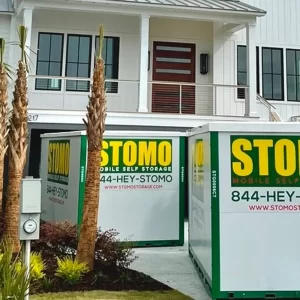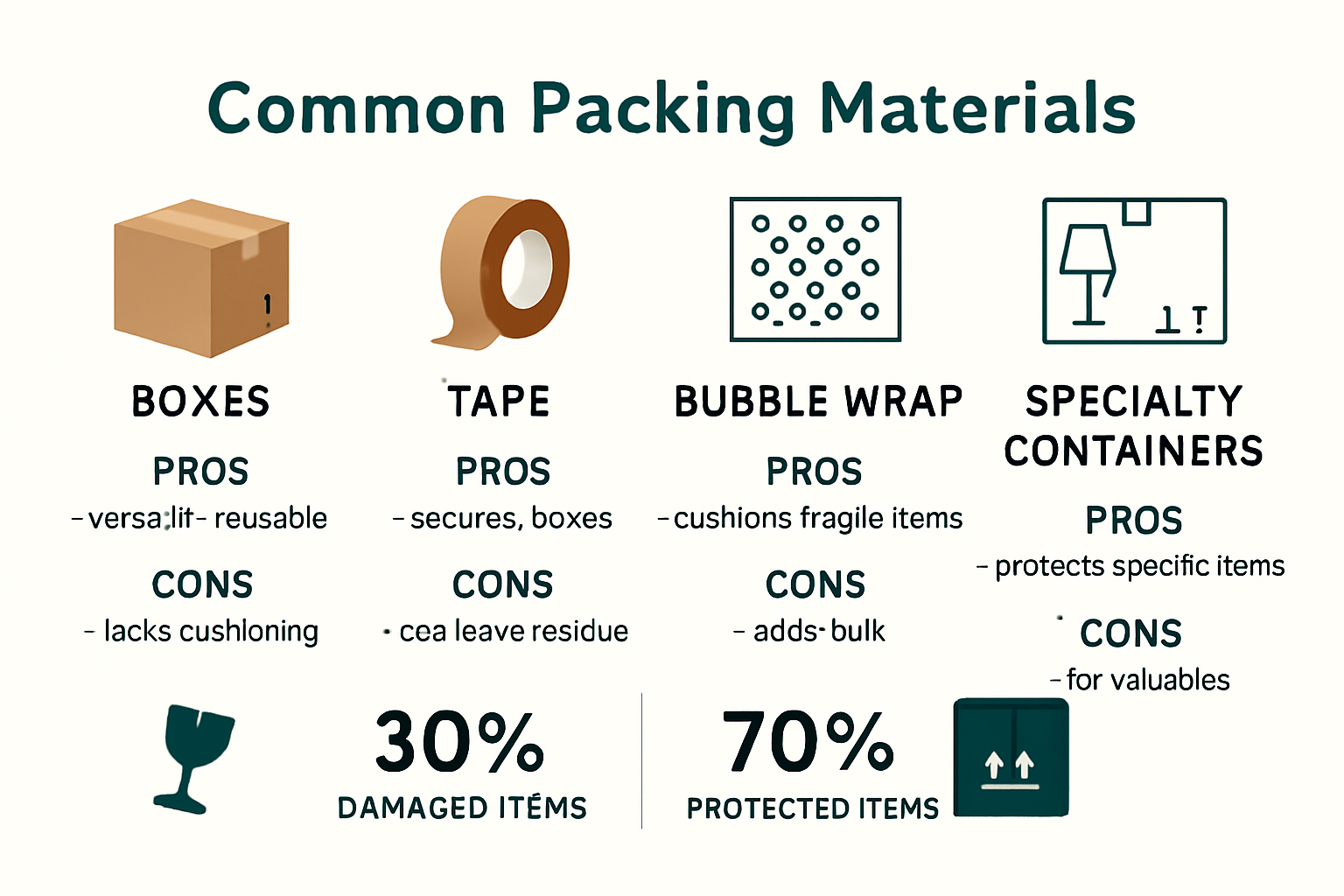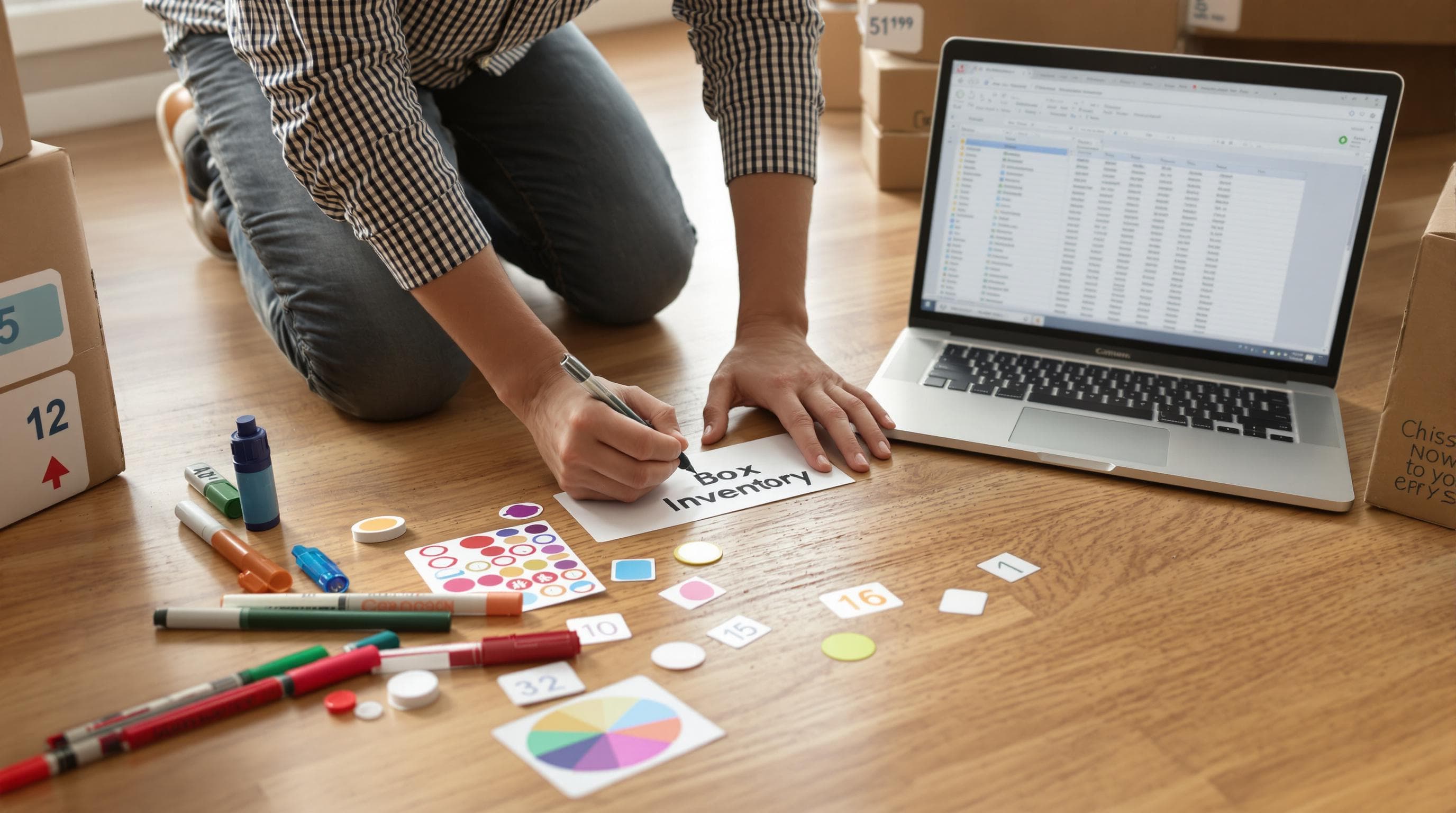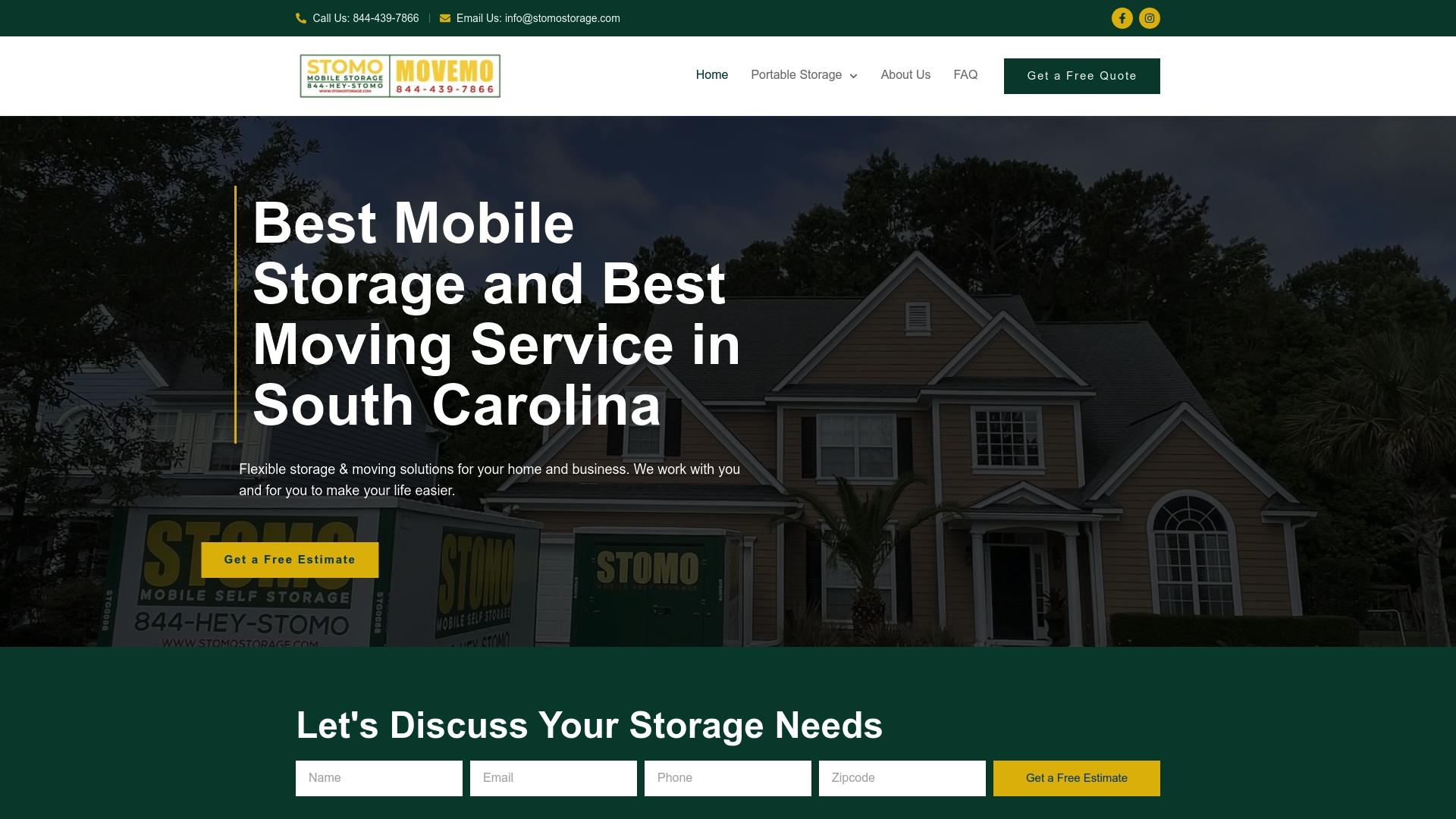
Packing for a move sounds simple and most people think a few boxes and tape will do the job. But nearly 60 percent of people report damaged or lost items after moving, even when they think they’ve packed carefully. The real secret is not what you put in boxes, but how you organize, label, and protect every single item for every unique situation.
Table of Contents
- Essential Packing Supplies And Smart Organization
- Time-Saving Hacks For Quick And Safe Packing
- Specialized Packing Tips For Unique Situations
- Storage And Moving Advice For South Carolina Residents
Quick Summary
| Takeaway | Explanation |
|---|---|
| Invest in Quality Packing Materials | Use sturdy boxes, strong tape, and specialty containers to protect your belongings effectively. High-quality materials reduce potential damage during transport. |
| Implement a Strategic Packing and Labeling System | Utilize a systematic approach with color-coded labels and an inventory spreadsheet for efficient organization, making unpacking easier. |
| Use Household Items as Protective Packing | Repurpose clothing, towels, and linens to cushion fragile items, saving money and reducing waste while packing. |
| Prepare for Unique Packing Needs | For fragile or valuable items, use specific packing strategies like custom crates and moisture protection for sensitive belongings. |
| Consider Local Climate in South Carolina | Use climate-controlled storage and waterproof materials to safeguard belongings against humidity and storm impacts unique to South Carolina’s geography. |
Essential Packing Supplies and Smart Organization
Moving can quickly become overwhelming without the right approach to packing and organization. Smart preparation transforms a potentially stressful experience into a smooth transition. Whether you’re relocating across town or preparing for a more complex move, having the right supplies and strategic organizational techniques makes all the difference.
The Foundation: Quality Packing Materials
The cornerstone of efficient packing starts with selecting high-quality materials. Professional movers recommend investing in sturdy boxes, strong packing tape, bubble wrap, and quality markers. According to Consumer Reports, using uniform box sizes can significantly improve loading efficiency and reduce potential damage during transport.
Choose boxes specifically designed for moving rather than repurposing old containers. Specialty boxes like wardrobe containers for clothing and dish pack boxes for fragile kitchenware provide extra protection. Corrugated cardboard boxes with double walls offer superior strength and can withstand more weight and handling stress.
Pro tip: Purchase slightly more packing supplies than you think you’ll need. Running out mid-packing can disrupt your entire workflow and create unnecessary stress. Plan for approximately 10-15% more materials than your initial estimate.

Strategic Packing and Labeling System
Organization is more than just throwing items into boxes. Develop a systematic approach that will save you time and frustration during unpacking. National Association of Productivity and Organizing Professionals recommends creating a comprehensive labeling system that goes beyond simply writing the room name.
Implement a color-coded or numbered labeling method. For instance, use different colored stickers or markers for each room, and number boxes within that room’s category. This technique allows for quick identification and helps movers or helpers understand exactly where each box belongs.

Create an inventory spreadsheet tracking each box’s contents. Include details like box number, room designation, and a brief list of items inside. This digital backup becomes invaluable if a box gets misplaced or you need to locate a specific item quickly.
For fragile items, use a clear “FRAGILE” label and add extra padding. Wrap delicate items individually in bubble wrap or packing paper, filling empty spaces to prevent movement during transit. Consider our guide on packing delicate items for more detailed strategies.
Remember that smart packing isn’t just about the materials you use but how strategically you use them. Take time to plan, organize, and protect your belongings. A little extra effort during packing can save significant time and stress during your move.
To help clarify the types of specialty boxes and their uses mentioned above, here’s a table summarizing key packing materials and their recommended uses:
| Packing Material | Description | Recommended Use |
|---|---|---|
| Standard Moving Box | Sturdy, uniform cardboard box | General household items |
| Double-Wall Corrugated Box | Extra-strong, double-layer cardboard | Heavy or fragile items |
| Wardrobe Box | Tall box with hanging rod | Clothes, coats, garments |
| Dish Pack Box | Thick-walled box with dividers | Fragile kitchenware, dishes, glassware |
| Bubble Wrap & Packing Paper | Protective wrapping materials | Wrapping fragile or delicate items |
| Strong Packing Tape | Heavy-duty adhesive tape | Sealing all boxes securely |
| Color-Coded Labels/Markers | Various colored stickers/markers | Organization by room/category |
Time-Saving Hacks for Quick and Safe Packing
Packing efficiently isn’t just about speed it’s about creating a smart system that protects your belongings while minimizing stress and time investment. The right approach can transform a potentially chaotic moving experience into a smooth and manageable process.
Rapid Packing Techniques for Maximum Efficiency
Time is of the essence when preparing for a move. Professional organizers recommend developing a strategic approach that maximizes your packing productivity. According to Professional Organizers Association, creating a comprehensive packing timeline can reduce overall moving stress by up to 40%.
Start by establishing a dedicated packing zone in your home. Choose a clear area where you can spread out supplies and work systematically. Use a timer to create focused packing sessions. Break your packing into 25-minute concentrated blocks with 5-minute breaks. This technique prevents burnout and maintains your energy levels throughout the packing process.
Prioritize rooms and items based on frequency of use. Pack rarely used spaces like guest rooms and storage areas first. Leave essential items and daily-use areas for last. Room-by-room packing allows you to maintain organization and track your progress effectively.
Smart Protection Strategies for Your Belongings
Speed should never compromise the safety of your items. Innovative packing methods can simultaneously save time and provide superior protection. Moving Industry Research Group suggests using household items as additional packing materials to both save time and reduce waste.
Utilize clothing, towels, and linens as protective padding for fragile items. Wrap glasses in clean socks, use t-shirts to cushion picture frames, and stuff towels around breakable decorative items. This approach eliminates the need to purchase excessive bubble wrap while ensuring your items remain secure during transit.
Create a quick-pack emergency kit with essential documents, medications, chargers, and a change of clothes. Keep this bag separately and easily accessible. Our guide on storage solutions provides additional strategies for maintaining quick access to critical items during your move.
Consider vacuum-sealing clothing and soft items to reduce volume and protect them from moisture. This technique saves considerable space and time during packing and unpacking. Use clear plastic bins for items you’ll need immediately upon arrival, making unpacking more straightforward and efficient.
Remember that efficient packing is a balance between speed and care. Take moments to breathe and stay organized. A methodical approach might take slightly longer initially but will save significant time and stress during the actual move. Each intentional step you take now reduces complications later in your moving journey.
Here’s a summary table to help you quickly choose the best household items to repurpose for packing certain belongings:
| Household Item | Protective Use | Ideal For |
|---|---|---|
| T-shirts | Wrapping fragile items | Picture frames, small electronics |
| Socks | Cushioning and wrapping | Glasses, cups, stemware |
| Towels | Padding and layering | Decorative items, kitchenware |
| Linens/Sheets | Lining boxes or wrapping | Large fragile items, mirrors, artwork |
| Plastic Bins | Waterproof, clear organization | Essentials for immediate access |
| Vacuum Bags | Reduce volume, protect from moisture | Clothing, bedding |
Specialized Packing Tips for Unique Situations
Every move presents its own set of challenges, and some belongings require extra care and specialized packing strategies. Whether you’re moving delicate antiques, valuable electronics, or handling long-distance relocations, understanding specific packing techniques can protect your most treasured possessions.
Handling Fragile and Valuable Items
Some items demand more than standard packing approaches. According to The International Art Movers Association, specialized packing for high-value items can reduce potential damage by up to 70%. Artwork, antiques, and delicate collections require meticulous preparation.
For artwork and sculptures, use custom-built wooden crates or specialized art shipping containers. Wrap each piece individually in acid-free tissue paper, then add multiple layers of bubble wrap. Create a cushioned environment using foam padding and ensure no movement is possible within the container. Museum-grade packing materials provide superior protection for irreplaceable items.
Electronics need particular attention. Remove batteries from devices and pack them separately to prevent potential leakage. Use original packaging when possible, or invest in anti-static bubble wrap designed specifically for electronic equipment. Consumer Electronics Protection Institute recommends creating a detailed inventory of electronic items, including serial numbers and current condition.
Specialized Solutions for Challenging Moving Scenarios
Some moves involve unique circumstances that require creative solutions. Military relocations, international moves, or moves involving extreme climate changes demand specialized strategies. Our comprehensive storage guide offers additional insights for complex moving situations.
For climate-sensitive items like musical instruments, wine collections, or sensitive electronics, consider temperature-controlled transportation. Use insulated containers and include moisture-absorbing packets to prevent humidity damage. Wooden instruments require extra care protect them from temperature fluctuations that can cause warping or cracking.
Pack important documents and irreplaceable personal items in waterproof, fireproof containers. Create digital backups of critical documents and store them securely in cloud storage. Include a separate emergency kit with copies of identification, insurance papers, and essential medical information.
Special consideration is needed for plants and pets during moves. For plants, use specialized plant moving boxes with ventilation. Wrap delicate pots in bubble wrap and secure them to prevent soil displacement. For pets, invest in professional pet moving containers that provide comfort and safety during transportation.
Remember that specialized packing is about anticipating potential challenges. Take time to research specific requirements for your unique items. Each careful step you take reduces the risk of damage and provides peace of mind during what can be a stressful moving process. Approach each item with patience and thoughtful preparation.
Storage and Moving Advice for South Carolina Residents
Moving and storage in South Carolina present unique challenges influenced by the state’s diverse geography, climate, and dynamic urban and rural landscapes. From coastal regions like Charleston to inland cities such as Columbia, residents require specialized strategies that account for humidity, potential storm impacts, and the state’s distinctive moving conditions.
Climate-Conscious Moving Strategies
South Carolina’s subtropical climate demands specific considerations during moving and storage. According to South Carolina Emergency Management Division, the state experiences high humidity and potential hurricane risks that can significantly impact moving and storage preparations.
Protect your belongings from moisture and potential storm damage by using climate-controlled storage solutions. Invest in waterproof packing materials and consider additional protective measures for electronics, wooden furniture, and sensitive items. Humidity-resistant packing techniques are crucial in preventing mold, mildew, and water damage during transitions.
Our portable storage solutions for South Carolina are specifically designed to withstand local environmental challenges. Choose storage containers with robust sealing and moisture protection to ensure your belongings remain safe during unpredictable weather conditions.
Local Moving Considerations for Different Regions
Moving within South Carolina varies dramatically depending on your specific location. Coastal areas like Charleston and Myrtle Beach present different logistical challenges compared to inland cities such as Columbia or Greenville. The South Carolina Association of Realtors highlights the importance of understanding regional moving nuances.
In coastal regions, consider additional protection for items susceptible to salt air and high humidity. Use marine-grade protective coverings and choose storage solutions that offer enhanced environmental protection. Inland moves might require different strategies, focusing more on temperature variations and potential seasonal changes.
Plan your move during less humid months if possible. Summer months can be particularly challenging, with temperatures often exceeding 90 degrees. Schedule moving activities during cooler morning or evening hours to minimize physical strain and protect temperature-sensitive items.
Emergency Preparedness and Flexible Storage Solutions
South Carolina’s vulnerability to natural events like hurricanes and tropical storms necessitates a proactive approach to moving and storage. Create a comprehensive emergency plan that includes quick-access storage options and protection strategies for your most valuable possessions.
Maintain digital backups of important documents and consider off-site storage for critical items. Use waterproof and fireproof containers for irreplaceable documents and valuables. Develop a flexible storage strategy that allows for quick relocation if emergency evacuation becomes necessary.
Understand local resources and emergency protocols specific to your county. Different regions in South Carolina may have unique evacuation routes and storage recommendations. Stay informed about local emergency management guidelines and develop a adaptable moving and storage plan.
Moving in South Carolina requires more than standard relocation strategies. By understanding local environmental challenges, leveraging specialized storage solutions, and maintaining flexibility, residents can ensure a smooth and secure moving experience. Each thoughtful preparation step reduces potential risks and transforms a potentially stressful transition into a manageable process.
Frequently Asked Questions
What are the best packing materials for moving?
Invest in sturdy boxes, strong packing tape, bubble wrap, and specialty containers designed for specific items. Using high-quality materials ensures better protection for your belongings during transport.
How can I effectively label my moving boxes?
Implement a color-coded labeling system for each room and number the boxes within that category. Additionally, create an inventory spreadsheet that tracks the contents of each box for easy reference during unpacking.
What are some time-saving packing hacks?
Establish a dedicated packing zone, prioritize packing rarely used items first, and utilize household items like clothes and towels as protective wrapping for fragile items. Consider using a timer for focused packing sessions to maintain productivity.
What should I do with fragile items during a move?
For fragile items, use specialized packing techniques such as wrapping each piece individually in bubble wrap and using custom crates for added protection. Clearly label these boxes as “FRAGILE” to ensure careful handling during the move.
Make Every Move Easy: Protect What Matters Most with Local Storage Experts
You learned the secrets to organized, stress-free packing in this guide—now take action with storage and moving solutions built for your real needs. Whether you are dealing with delicate heirlooms, unpredictable South Carolina weather, or just need a simple way to pack and unpack at your own speed, Stomo is here. We offer portable, weather-resistant storage containers and moving services that are tailored for South Carolina families and businesses. Discover why locals trust us for home renovations, storm recovery, college moves, and beyond by visiting our services page.

Why wait and risk damage, lost time, or stress with a move? Skip confusing hourly rates and avoid national chains that charge hidden fees. Experience the difference that comes with a family-owned, local South Carolina team offering flat-rate pricing, fast response, and true personal attention. See more about how our award-winning storage and moving solutions can help you protect and organize your biggest move yet. Ready to take the next step? Click now for a personalized quote and discover how easy moving in South Carolina was meant to be.
Recommended
- How to Pack a Storage Unit: Expert Guide for Every Need 2025 – STOMO Mobile Storage and MOVEMO Moving Service
- portable storage South Carolina
- Military Move Guide 2025: Storage and Moving Tips for Every Need – STOMO Mobile Storage and MOVEMO Moving Service
- Renovation Renovation Renovation: Smart Solutions for 2025 – STOMO Mobile Storage and MOVEMO Moving Service
- House Removal Process Explained: Step-by-Step Guide for 2025 | Schott Removals
